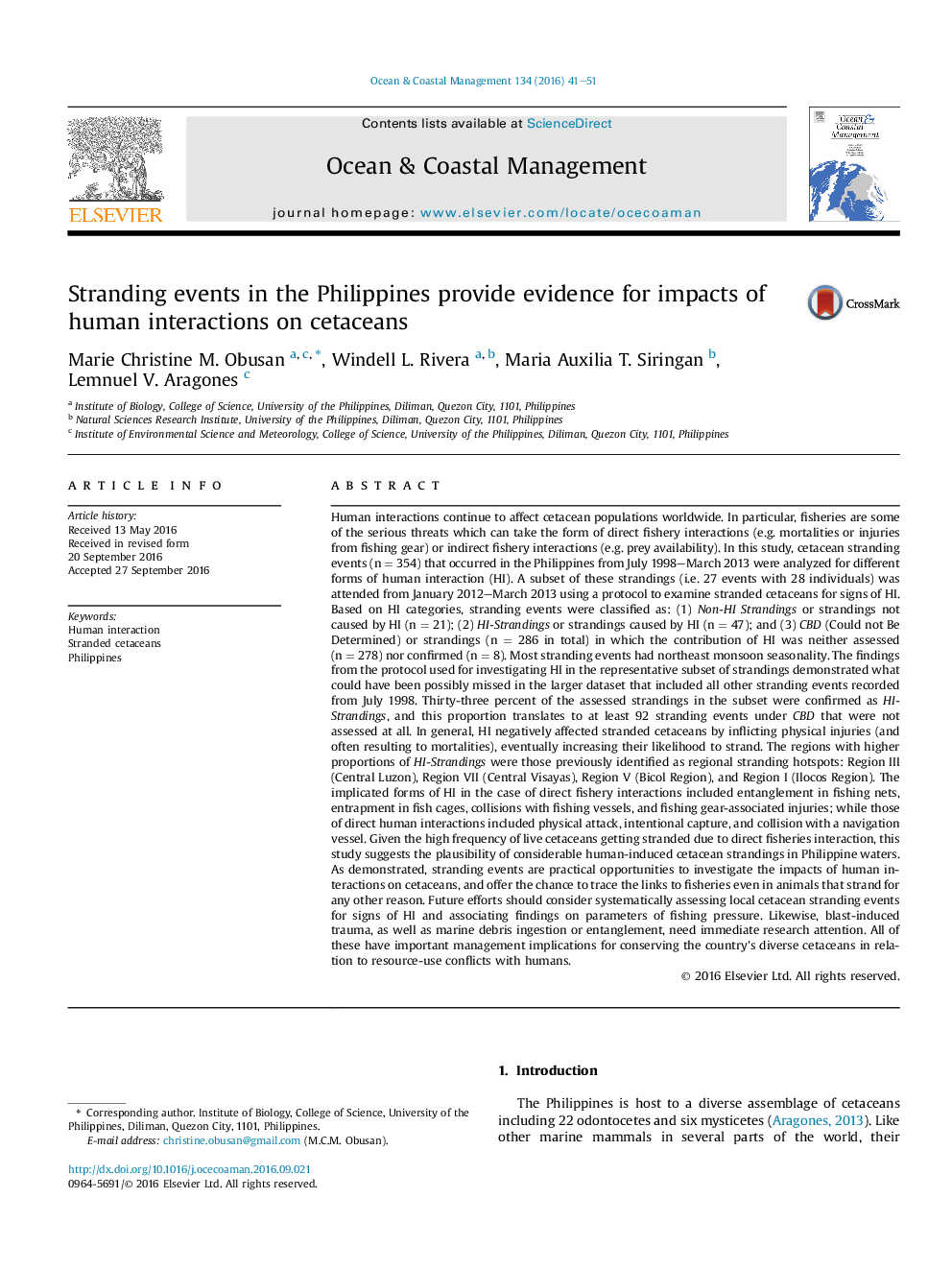| کد مقاله | کد نشریه | سال انتشار | مقاله انگلیسی | نسخه تمام متن |
|---|---|---|---|---|
| 5473916 | 1520495 | 2016 | 11 صفحه PDF | دانلود رایگان |
عنوان انگلیسی مقاله ISI
Stranding events in the Philippines provide evidence for impacts of human interactions on cetaceans
ترجمه فارسی عنوان
حوادث تهاجمی در فیلیپین شواهدی برای تأثیرات تعاملات انسانی در بوته هاست
دانلود مقاله + سفارش ترجمه
دانلود مقاله ISI انگلیسی
رایگان برای ایرانیان
کلمات کلیدی
تعامل انسان، سیب زمینی سرگردان فیلیپین،
موضوعات مرتبط
مهندسی و علوم پایه
علوم زمین و سیارات
اقیانوس شناسی
چکیده انگلیسی
Human interactions continue to affect cetacean populations worldwide. In particular, fisheries are some of the serious threats which can take the form of direct fishery interactions (e.g. mortalities or injuries from fishing gear) or indirect fishery interactions (e.g. prey availability). In this study, cetacean stranding events (n = 354) that occurred in the Philippines from July 1998-March 2013 were analyzed for different forms of human interaction (HI). A subset of these strandings (i.e. 27 events with 28 individuals) was attended from January 2012-March 2013 using a protocol to examine stranded cetaceans for signs of HI. Based on HI categories, stranding events were classified as: (1) Non-HI Strandings or strandings not caused by HI (n = 21); (2) HI-Strandings or strandings caused by HI (n = 47); and (3) CBD (Could not Be Determined) or strandings (n = 286 in total) in which the contribution of HI was neither assessed (n = 278) nor confirmed (n = 8). Most stranding events had northeast monsoon seasonality. The findings from the protocol used for investigating HI in the representative subset of strandings demonstrated what could have been possibly missed in the larger dataset that included all other stranding events recorded from July 1998. Thirty-three percent of the assessed strandings in the subset were confirmed as HI-Strandings, and this proportion translates to at least 92 stranding events under CBD that were not assessed at all. In general, HI negatively affected stranded cetaceans by inflicting physical injuries (and often resulting to mortalities), eventually increasing their likelihood to strand. The regions with higher proportions of HI-Strandings were those previously identified as regional stranding hotspots: Region III (Central Luzon), Region VII (Central Visayas), Region V (Bicol Region), and Region I (Ilocos Region). The implicated forms of HI in the case of direct fishery interactions included entanglement in fishing nets, entrapment in fish cages, collisions with fishing vessels, and fishing gear-associated injuries; while those of direct human interactions included physical attack, intentional capture, and collision with a navigation vessel. Given the high frequency of live cetaceans getting stranded due to direct fisheries interaction, this study suggests the plausibility of considerable human-induced cetacean strandings in Philippine waters. As demonstrated, stranding events are practical opportunities to investigate the impacts of human interactions on cetaceans, and offer the chance to trace the links to fisheries even in animals that strand for any other reason. Future efforts should consider systematically assessing local cetacean stranding events for signs of HI and associating findings on parameters of fishing pressure. Likewise, blast-induced trauma, as well as marine debris ingestion or entanglement, need immediate research attention. All of these have important management implications for conserving the country's diverse cetaceans in relation to resource-use conflicts with humans.
ناشر
Database: Elsevier - ScienceDirect (ساینس دایرکت)
Journal: Ocean & Coastal Management - Volume 134, December 2016, Pages 41-51
Journal: Ocean & Coastal Management - Volume 134, December 2016, Pages 41-51
نویسندگان
Marie Christine M. Obusan, Windell L. Rivera, Maria Auxilia T. Siringan, Lemnuel V. Aragones,
